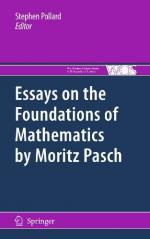|
This section contains 395 words (approx. 2 pages at 300 words per page) |
World of Mathematics on Moritz Pasch
Moritz Pasch's mathematical work provided one of the foundations for modern mathematics, especially geometry. In fact, Pasch was the first mathematician since Euclid who presented geometric elements in relationships defined by abstract, formal axioms. By doing this, he discovered that there were a certain amount of assumptions in Euclid's work that had been previously overlooked. In conjunction with this work, Pasch also developed Pasch's axiom, which deals with lines and triangles. He played a central role in the development of the axiomatic method that is a central feature of 20th century mathematics.
Pasch was born in Breslau, Germany (now Worclaw, Poland) on November 8, 1843. He attended the Elisabeth Gymnasium in Breslau, and completed his education in Berlin and Giessen. Pasch began studying chemistry then switched to mathematics at the behest of a mentor. He published his dissertation in 1865.
Pasch spent his teaching career at one institution, the University of Giessen. He began there in 1870 as a lecturer, then moved rapidly up the ranks to a full professorship in 1875. In 1888, Pasch became chair of the department. Pasch also served the university in administrative capacities, serving as dean in 1883, and, in the 1893-94 academic year, as rector (a position equivalent to that of president). Leading a relatively simple life, Pasch also married at one point and with his wife, had two daughters, though his wife and one daughter died young.
As a mathematician, Pasch spent the first 17 years of his career studying algebraic geometry, then moved onto foundations. He published his most important work, Vorlesungen über Neuere Géométrie, in 1882. In this treatise, Pasch addressed descriptive geometry from an axiomatic point of view. His work is distinguished because he eschewed physical interpretation of mathematical terms in favor of purely formal axioms. He also defined what is now known as Pasch's axiom, which states that in a triangle ABC, if a line enters through side AB and does not pass through the C, then it must leave the triangle either between B and C, or between C and A.
Pasch retired from the University of Giessen in 1911 to devote himself to mathematical research full time. In 1923 his work was recognized by his peers when Pasch received two honorary doctoral degrees from the University of Freiburg and the University of Frankfurt. He died seven years later in Bad Hamburg while on vacation on September 20, 1930.
|
This section contains 395 words (approx. 2 pages at 300 words per page) |


